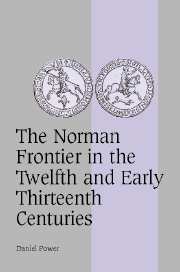Book contents
- Frontmatter
- Contents
- List of maps
- List of tables
- Preface
- Notes on names, dates, manuscripts and coinage
- Note on maps
- List of abbreviations
- Introduction
- Part I PRINCELY POWER AND THE NORMAN FRONTIER
- Part II THE POLITICAL COMMUNITIES OF THE NORMAN FRONTIER
- Part III THE POLITICAL DEVELOPMENT OF THE NORMAN FRONTIER
- Conclusion
- Appendix I Genealogies
- Appendix II The campaigns in eastern Normandy (1202)
- Bibliography
- Index
Appendix II - The campaigns in eastern Normandy (1202)
Published online by Cambridge University Press: 22 September 2009
- Frontmatter
- Contents
- List of maps
- List of tables
- Preface
- Notes on names, dates, manuscripts and coinage
- Note on maps
- List of abbreviations
- Introduction
- Part I PRINCELY POWER AND THE NORMAN FRONTIER
- Part II THE POLITICAL COMMUNITIES OF THE NORMAN FRONTIER
- Part III THE POLITICAL DEVELOPMENT OF THE NORMAN FRONTIER
- Conclusion
- Appendix I Genealogies
- Appendix II The campaigns in eastern Normandy (1202)
- Bibliography
- Index
Summary
The sources for the opening campaigns of the war of 1202–4 are contradictory, yet an attempt to reconstruct these events is justified, for they cast an interesting light upon the collapse of Angevin rule in eastern Normandy in 1202. The speed of that collapse, and the apparent lack of resistance except at Radepont, Gournay and Arques, requires explanation. Unfortunately, the chief narrative sources for these events, Rigord, William the Breton, Ralph of Coggeshall and Roger of Wendover, cannot be reconciled with each other or with the chancery rolls, which give an approximate indication of John's movements. However, if the sources are considered in conjunction with the French royal accounts and the geography of landownership in north-eastern Normandy, it is possible to reconstruct the sequence of events in considerable detail and with some coherence.
Several accounts state that Philip began the war by capturing and levelling Richard's new castle at Boutavant. Most agree that he next took a number of fortresses lying between the Forest of Lyons and the English Channel, before turning back to capture Gournay. At some point in the spring or summer of 1202 he gave custody of the nearby fortress of Formerie to the bishop of Beauvais. From Gournay the king of France marched to besiege Arques, until the news of Arthur's capture at Mirebeau reached him. The difficulty lies in establishing how and when he achieved these successes, and how they relate to John's movements in the same period (see Map IX).
- Type
- Chapter
- Information
- Publisher: Cambridge University PressPrint publication year: 2004



